National Healthcare Quality and Disparities Report
Latest available findings on quality of and access to health care
Data & Analytics
- Data Infographics
- Data Visualizations
- Data Tools
- Data Innovations
- All-Payer Claims Database
- Consumer Assessment of Healthcare Providers and Systems (CAHPS®) Program
- Healthcare Cost and Utilization Project (HCUP)
- Medical Expenditure Panel Survey (MEPS)
- National Healthcare Quality and Disparities Report Data Tools
- Network of Patient Safety Databases
- AHRQ Quality Indicator Tools for Data Analytics
- Surveys on Patient Safety Culture
- United States Health Information Knowledgebase (USHIK)
- Data Sources Available from AHRQ
Search Publications
The Agency for Healthcare Research and Quality (AHRQ)'s publications offer practical information to help a variety of health care organizations, providers, and others make care safer in all health care settings.
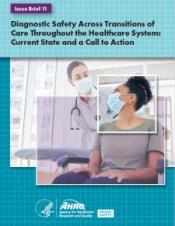
Diagnostic Safety Across Transitions of Care Throughout the Healthcare System: Current State and a Call to Action
Diagnostic Safety Issue Brief #11
This issue brief examines the existing evidence base on how to improve diagnostic safety at intrahospital care transitions, from using data analysis tools to using structured communication frameworks.
Publication Date: Publication Number: 23-0040-1-EF
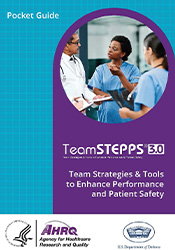
Pocket Guide: TeamSTEPPS
TeamSTEPPS is a teamwork system developed jointly by the Department of Defense (DoD) and the Agency for Healthcare Research and Quality (AHRQ) to improve institutional collaboration and communication relating to patient safety.
Publication Date: Publication Number: 23-0043
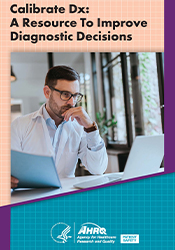
Calibrate Dx: A Resource To Improve Diagnostic Decisions
This resource has three tools: a quick start guide, a resource with exercises and tools, and a clinical leaders guide.
Publication Date: Publication Number: 22(23)-0047-2-EF
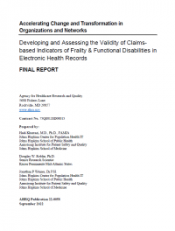
Developing and Assessing the Validity of Claims-based Indicators of Frailty & Functional Disabilities in Electronic Health Records
The project findings demonstrated that structured EHR data can be used by healthcare providers to identify frail patients using validated EHR frailty indexes; however, claims data can identify additional frailty cases compared to EHR data.
Publication Date: Publication Number: 22-0058
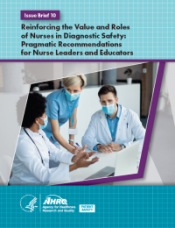
Reinforcing the Value and Roles of Nurses in Diagnostic Safety: Pragmatic Recommendations for Nurse Leaders and Educators
Diagnostic Safety Issue Brief #10:
This issue brief describes pragmatic approaches for nurse educators and leaders to convey the urgent need to improve diagnosis among their nurses and care teams and to guide nurses to embrace their leadership roles in the diagnostic process.
Publication Date: Publication Number: 22-0026-4-EF

Reducing Healthcare Carbon Emissions: A Primer on Measures and Actions for Healthcare Organizations to Mitigate Climate Change
To support healthcare organizations in advancing toward their decarbonization commitments, AHRQ contracted with the Institute for Healthcare Improvement to develop a primer that offers guidance on high-priority measures and strategies for healthcare organizations to reduce their carbon footprint.
Publication Date: Publication Number: 22-M011

How To Create a My Medicines List
My Medicines List can remind you when, how, and how much medicine to take. Here are step-by-step instructions to create a My Medicines List for yourself, a family member, a friend, or anyone you take care of.
Publication Date: Publication Number: 22-0062
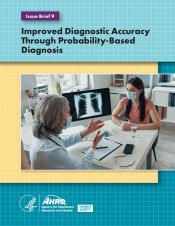
Improved Diagnostic Accuracy Through Probability-Based Diagnosis
Diagnostic Safety Issue Brief #9:
This issue brief presents a framework that outlines the diagnostic process and highlights the role of probabilistic understanding at each step. The framework lays out the information needed throughout the diagnostic process to help clinicians make accurate probability assessments.
Publication Date: Publication Number: 22-0026-3-EF
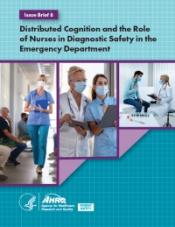
Distributed Cognition and the Role of Nurses in Diagnostic Safety in the Emergency Department
Diagnostic Safety Issue Brief #8:
This issue brief discusses the nurse’s role in diagnostic safety, using the conceptual lens of distributed cognition. It describes the theory of distributed cognition, discusses the nurse’s role in diagnosis through that conceptual lens, and concludes with suggestions for future areas of practice and research.
Publication Date: Publication Number: 22-0026-2-EF
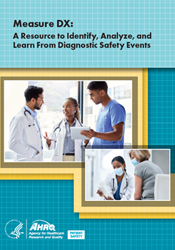
Measure Dx: A Resource To Identify, Analyze, and Learn From Diagnostic Safety Events
The Measure DX Guide is a resource to help healthcare organizations detect, analyze, and learn from diagnostic safety events. Measure Dx can be used by any healthcare organization interested in promoting diagnostic excellence and reducing harm from diagnostic safety events. Potential users include clinicians, quality and safety professionals, risk management professionals, health system leaders, and clinical managers.
Publication Date: Publication Number: 22-0038



